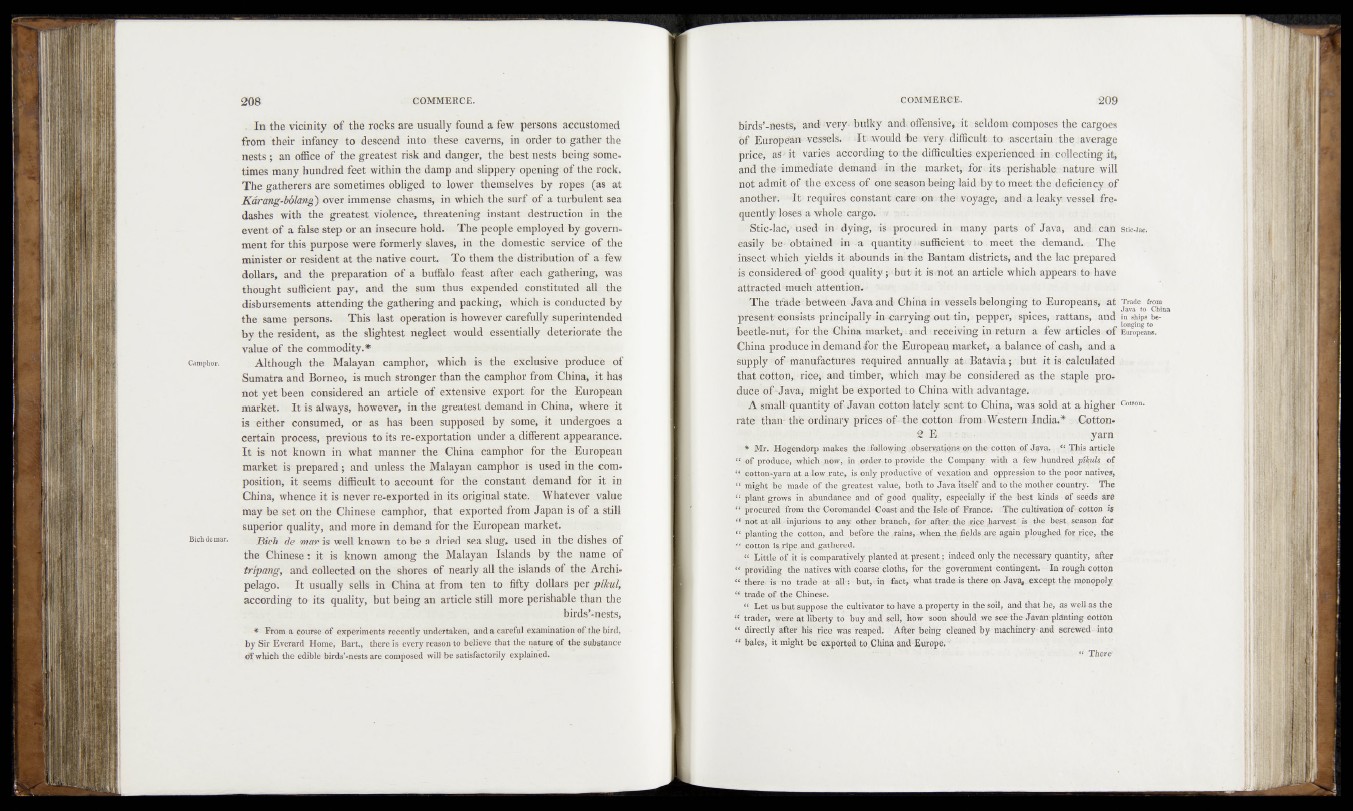
. In the vicinity of the recks are usually found a few persons accustomed
from their infancy to descend into--these caverns, in order toi gather the
nests ; an office of the greatest risk and danger, ::the best nests being sometimes
many.hundred feet within the damp and slippery opening of the rock.
The gatherers are sometimes obliged to lower themselves by ropes (as at
Kdrang-bdlang). over immense chasms, in which the surf of a turbulent sea
dashes with the greatest violence^ threatening instant destruction in the
event of a false step or an insecure hold. The people employed by govern,
ment fear this purpose were formerly slaves, in the domestic'service of. the
minister or resident at the native court. To them the distribution of a-few
dollars, and the preparation of a buffalo feast after each gathering, was
thought sufficient pay, and the sum thus expended constituted all^the
disbursements attending the gathering and packing, which, is conducted by
the same persons. This last operation is however carefully superintended
by the resident, as the slightest neglect would essentially deteriorate the
value of the commodity.*
cipher. Although the Malayan camphor, which ids- the exclusive produce of
Sumatra and Borneo, is much stronger than the camphor from China* it has
not yet been considered an article of extensive export for the European
market. I t is always, however, in the greatest demand in ’China, where it
is either consumed, or as has been supposed by some* it .undergoes a
certain process, previous to its re-exportation under a. different appearance*
I t is not known in what manner the China camphor for the-iBurdpean
market is prepared; and unless the Malayan camphor is used in-the com*
position, it seems difficult to account for the constant demand for . if in
China, whence it is never re-exported in its original state. I Whatever value
may be set on the Chinese camphor, that exported from Japan is'.of a: still
superior quality, and more in demand for the European market.
Btehdemar. T&ch < de■ mar is well known to be a dried sea slug, used in. the dishes of
the Chinese: it is known among the Malayan Islands by the name of
tripang, and collected on the shores of nearly all the islands of the Archipelago.
It usually sells in China at from ten to fifty dollars per pikul,
according to its quality, but being an article still more perishable than the
I . birds’-nests,
* From a course of experiments recently undertaken, and a earefid. examination ofithe bird,
• by Sir Everard Home, Bart., there is ifeyfe'ry reason to believe that the nature of the si&stance
df which the edible birds’-nests are composed will be satisfactorily explained.
feirds’-uestsv and! *vesy»-bulky and«'offensive, iteseldonucomposes the cargoes
ilf Europe^»-'^ essels. - 1 lift would, fei-wry difficult«.!». ascertain rthej average
aSJ it- varied aeeordmg to^the.difE'cmlties.'experi&ucediifc'ecEllecting. it,,
arid 'thdrimihediate drimandnan theI market^ for its ^perishabfedteture. will
riot! admit of the'eAGfess Qf ejae sEason heang ilaidsby to meet-the: deficiency; of
ariotherv ’4# requires constant !eare?tni»lhe:i#oyage} '-andv a leakyr.vessel fre*
buentlyj lose'S'a whole- GSrg&. n ge
::'Stic-ladp bsed> in- dying, 'is-procureds in. .many parts of Java* and can sticJae.
easily bri'-iobtainedoffri’Ja quantity-sjeiaffieient;1. to . meet thes demand«. The
fSsectwhieh yields ’it^abounds in-the BantamAistrict8,-»and the lac prepared
is; considereehof -good? quality ;«but it ienaot an article whieh appears, tohave
attracted -muds .abMalioSfc» 1
The trSdeihet^edn-Java and CMria dff.vnssels beloneirag to European« «at Tutfe from
, ■, < . i . „ H j mH b I mm i Java to China presentMsonsists 'princfpally'in.icarryingiioutitinp pepper,'ispices, arafetans, .and in ship« hebeetle
mrt$ '-foivthe China market,) t and ireeeiteing in« return;at few articles-;of European*.
China produce in demandfor the European market, a balance of cash, .and «a
§figfiI^ofemfanufacttir-es required annually. abuBataviri;. but it isi calculated U
that cottonji-riberi and timber, which maybe considered as ithe staple pro*
duibe*bfeJav»/ rriight bedxpoFtedtO China with advantage, v.
A small* quantity of Javan cotton lately sentoto Cbjna,'waa sold-Jtt a higher Cott0B‘
r'ate’- than* thfe ordinary prices bfi-*the cotton irom.WestemJndia.* vvGoiffcn*
v. : ; „ .<. ■ .yarn
* Mr. HogCndorp makes the following observations on the cotton of Java. “ This article
p i^ d i^ 2^Jueh^pjv,fin .nrder. to provide the Company wifff a £ew*,hgndrcdj$|?<& of
^|cottQrr-y^rr(.at. asiojy.jate, is onlv productive of vexation and oppression to ihe.poor natives,
rfiight^be made of the’ greatest value., both to Java itself and to the mother country.1 ’The
“ pant grows in abundance and of good Quality, esptecially'if-the -best kinds of seeds are
“ -procttted fro'm- the Coromandel Coast and the Isle of France: The cultivation of. cotton is
“ not aWald^inJarious to any other branch,;for .after/jthe «rice^aryget'is tb,e best,, season for
“ planting the cotton, and before the ,rain6, -when,. the, jGpl.ds .arc again plpggl^d .foi; riqe, the
{{ .jeotkon ixjrige,.and.gathpred. ...
* 5 p ttle of ,it“is' comparatively planted at present,; indeed only the necessary quantity, after
“ providing the natives with coarse'cloths, for - the • government - contingent, - In rough cotton
« therecis-‘hd trade--at- all-: but,tin «fact,- what.trade.is there.op Jqrg,,.. excQgf the mpnppoly
“ trade of the Chinese.
“ Let us but suppose the cultivator to have a property in the soil, and that he, as woll as the
“ trader, yere at liberty to arid sell,_hbw soon should ,we see1 the- Javan-planting cotton
“ directly after his lice was reaped': After being cleaned b y machinery-and screwed -into
“ bales,’ it might:Tje "exported totCftina and-Europe.J -
“ There’